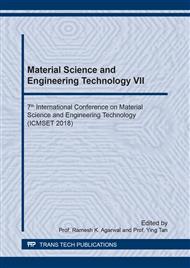[1]
Mehta, P.K. and Monteriro, P.J. (2013). Concrete: Microstructure, Properties and Materials. 4th edn. MCGraw Hill, USA.
Google Scholar
[2]
Mostofinejad, D., Nikoo, M. R., & Hosseini, S. A. (2016). Determination of optimized mix design and curing conditions of reactive powder concrete (RPC). Construction and Building Materials, 123, 754-767.
DOI: 10.1016/j.conbuildmat.2016.07.082
Google Scholar
[3]
Neville, A.M. (2011). Properties of Concrete. 5th edn. Pearson, Harlow, Essex, UK.
Google Scholar
[4]
Abbas, S., Nehdi, M. L., & Saleem, M. A. (2016). Ultra-high performance concrete: Mechanical erformance, durability, sustainability and implementation challenges. International Journal of Concrete Structures and Materials, 10(3), 271-295.
DOI: 10.1007/s40069-016-0157-4
Google Scholar
[5]
Ahmad, S., Zubair, A., & Maslehuddin, M. (2015). Effect of key mixture parameters on flow and mechanical properties of reactive powder concrete. Construction and Building Materials, 99, 73-81.
DOI: 10.1016/j.conbuildmat.2015.09.010
Google Scholar
[6]
Zheng, W., Luo, B., & Wang, Y. (2013). Compressive and tensile properties of reactive powder concrete with steel fibres at elevated temperatures. Construction and Building Materials, 41, 844-851.
DOI: 10.1016/j.conbuildmat.2012.12.066
Google Scholar
[7]
Hiremath, P., & Yaragal, S. C. (2017). Investigation on Mechanical Properties of Reactive Powder Concrete under Different Curing Regimes. Materials Today: Proceedings, 4(9), 9758-9762.
DOI: 10.1016/j.matpr.2017.06.262
Google Scholar
[8]
Ali, M. H., Dinkha, Y. Z., & Haido, J. H. (2017). Mechanical properties and spalling at elevated temperature of high performance concrete made with reactive and waste inert powders. Engineering Science and Technology, an International Journal, 20(2), 536-541.
DOI: 10.1016/j.jestch.2016.12.004
Google Scholar
[9]
American Society for Testing and Materials, Standard Test Method for Compressive Strength of Hydraulic Cement Mortars, ASTM C109, ASTM International, West Conshohocken, PA, USA, (2016).
Google Scholar
[10]
Soroka, I. (1979). Portland Cement Paste and Concrete, The Macmillan Press Ltd, London, pp.87-91.
Google Scholar


